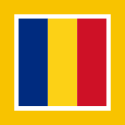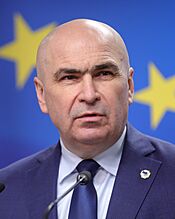Prime Minister of Romania facts for kids
Quick facts for kids Prime Minister of the Government of Romania |
|
|---|---|

Standard of the Prime Minister of Romania
|
|
| Style | His/Her Excellency |
| Member of | Government of Romania Supreme Council of National Defence |
| Seat | Victoria Palace, Bucharest |
| Appointer | President of Romania |
| Term length | 2 years
No term limit
|
| Inaugural holder | Barbu Catargiu as President of The Council of Ministers |
| Formation | 22 January 1862 |
| Salary | 288,000 lei annually (2022) |
The Prime Minister of Romania (Romanian: Prim-ministrul României) is the main leader of the Romanian Government. This person is in charge of running the country's daily affairs. The official title is "Prime Minister of the Government of Romania."
Long ago, this job was called "President of the Council of Ministers." This was because the "Government" included more than just the Cabinet, which was then called the "Council of Ministers." The name officially changed to "Prime Minister" in 1965.
Contents
How a Prime Minister Is Chosen
The President's Role
The President of Romania has an important job: choosing someone to be the Prime Minister. The President talks with the political party that has the most seats in the Parliament. If no single party has a majority, the President talks with all the parties in Parliament.
Forming a Government
Once a person is chosen, they become the "candidate" for Prime Minister. This candidate then creates a plan for how the government will work. They also pick the people who will be in their Cabinet (the group of ministers).
This plan and the list of Cabinet members must be shown to the Parliament. Parliament has ten days to approve it. Both the Chamber of Deputies and the Senate discuss the plan and the Cabinet members together.
For the plan to be accepted, most of the deputies and senators must vote "yes." If they approve, the candidate officially becomes the Prime Minister. All the chosen Cabinet members become ministers.
Taking the Oath
The new Prime Minister and all the ministers must then take an oath. This is a special promise they make to the President. After taking the oath, they officially start their jobs.
What the Prime Minister Does
Leading the Government
The Prime Minister leads the government and makes sure all its members work together. They present reports and plans to Parliament, explaining what the government is doing. The Prime Minister is responsible for guiding the country's internal policies. They also lead the public administration, which means managing how the country is run day-to-day.
Rules for the Job
A Prime Minister cannot hold many other jobs at the same time. They can be a deputy or a senator, but they cannot work in a commercial business.
A Prime Minister's job can end in several ways:
- They might resign (quit).
- Parliament might vote them out (this is called a motion of no confidence).
- They might lose their right to vote (if they are convicted of a crime).
- They might take another job that is not allowed.
- They might pass away.
- The term of the Parliament might end.
Making Decisions
The Prime Minister, along with the minister in charge of a specific area, can sign special orders. These orders are called "resolutions" or "ordinances." They become official when they are published in the Monitorul Oficial, which is Romania's official newspaper for government news.
These orders must be sent to Parliament quickly for discussion. If Parliament does not discuss or approve an order within 30 days, it automatically becomes law. However, emergency orders cannot change the country's main laws (the Constitution). They also cannot affect how important government bodies work, or change people's basic rights and freedoms.
Relationship with the President
In Romania, the Prime Minister is not directly controlled by the President. The President cannot simply fire the Prime Minister.
The President can attend government meetings, especially when important topics like foreign policy, national defense, or public order are discussed. The Prime Minister can also invite the President to other meetings. When the President attends a meeting, they are always the one in charge of that meeting.
Usually, the Prime Minister is also the leader of the main political party that supports the government. But this is not always the case.
Working with Parliament
Sharing Information
The government and its members must give Parliament any information, reports, or documents it asks for. This helps Parliament keep an eye on what the government is doing.
Answering Questions
Members of the government, including the Prime Minister, can attend Parliament meetings. They must go if the leaders of the Chamber of Deputies or the Senate ask them to. The Prime Minister and ministers must answer questions from deputies and senators. After these questions, Parliament can make a statement about a political issue.
Voting Out the Government
Parliament can remove a Prime Minister and their Cabinet by passing a "motion of no confidence." To start this process, at least one-quarter of the deputies and senators must sign the motion. For it to pass, most deputies and senators must vote for it.
If a motion of no confidence passes, the Prime Minister and their Cabinet are officially dismissed. Then, the President must choose someone new to form a new government.
Since 1989, five Prime Ministers have been removed this way:
- Emil Boc (in 2009)
- Mihai Răzvan Ungureanu (in 2012)
- Sorin Grindeanu (in 2017)
- Viorica Dăncilă (in 2019)
- Florin Cîțu (in 2021)
History of the Prime Minister's Role
Early Beginnings (1862)
The job of Prime Minister was first created in 1862. Back then, it was called "President of the Council of Ministers." This happened during the rule of Prince Alexandru Ioan Cuza.
Cuza was special because he was elected Prince of Wallachia and Moldavia in 1859. This brought the two areas together. By 1862, he had fully joined their governments, creating the new country of Romania with its capital in Bucharest.
Cuza wanted the country to have a political government. So, he created the Prime Minister's job and chose Barbu Catargiu as the first one.
Changes in Power
At first, the Prime Minister had a lot of power. Catargiu's government, along with the Legislative Assembly, could even challenge the Prince's wishes. They were able to delay some important reforms.
Prince Cuza became frustrated. In 1864, he took strong action, changing the country's main law (the Constitution). This new law gave the Prince more power and made the Prime Minister his subordinate. Even so, the Prime Minister remained important. For example, Mihail Kogălniceanu, the third Prime Minister, often disagreed with Cuza.
After Cuza was removed from power in 1866, a new constitution was written. The 1866 Constitution stated that the Prince could appoint and dismiss the Prime Minister at any time. But the Prime Minister still had a lot of influence.
After World War I
After World War I, Romania became much larger. A new constitution was created in 1923 to reflect these changes. This new constitution limited the King's powers. It gave most of the executive power to the Prime Minister and their Cabinet. They now governed in the King's name after he appointed them.
The 1923 Constitution also started to give Parliament more control over the government. It allowed Parliament to accuse ministers of wrongdoing and put them on trial.
Where the Prime Minister Works
The Prime Minister's main office is at Victoria Palace in Bucharest.
This beautiful palace was first designed to be the headquarters for the Foreign Ministry. During the time of the communist government, it housed both the Foreign Ministry and the Council of Ministers. After 1989, when Romania became a democratic country again, Victoria Palace became the headquarters for the first post-communist government.
In 2004, Victoria Palace was officially recognized as a historical monument.
See also
 In Spanish: Primer ministro de Rumania para niños
In Spanish: Primer ministro de Rumania para niños
- List of presidents of Romania
- List of heads of government of Romania
- List of heads of government of Romania by time in office


